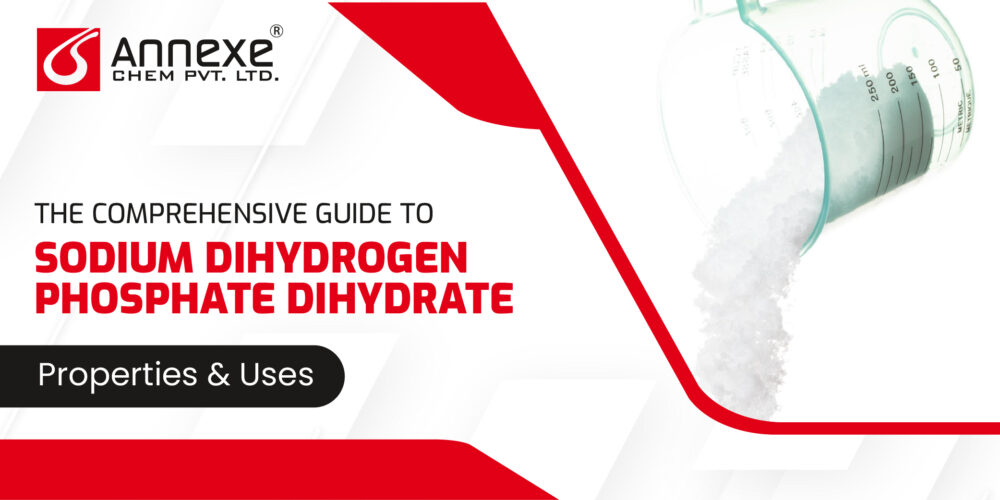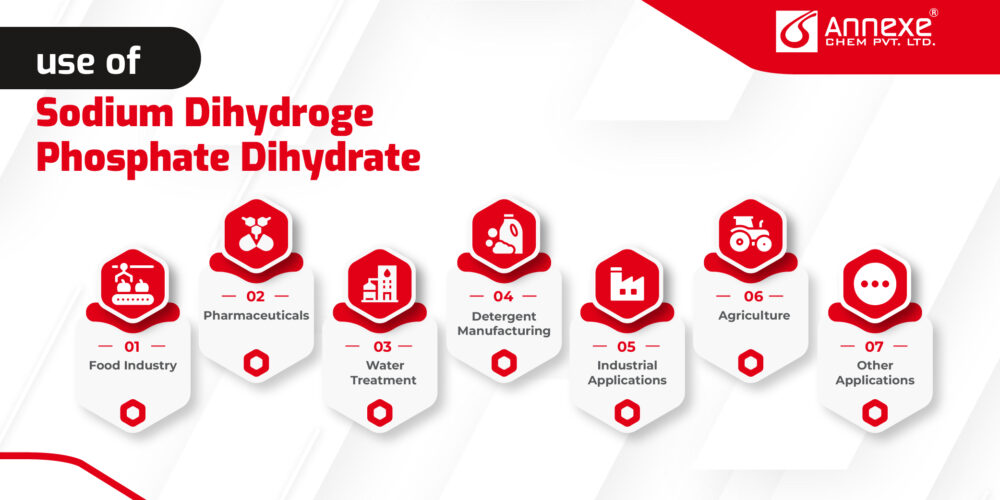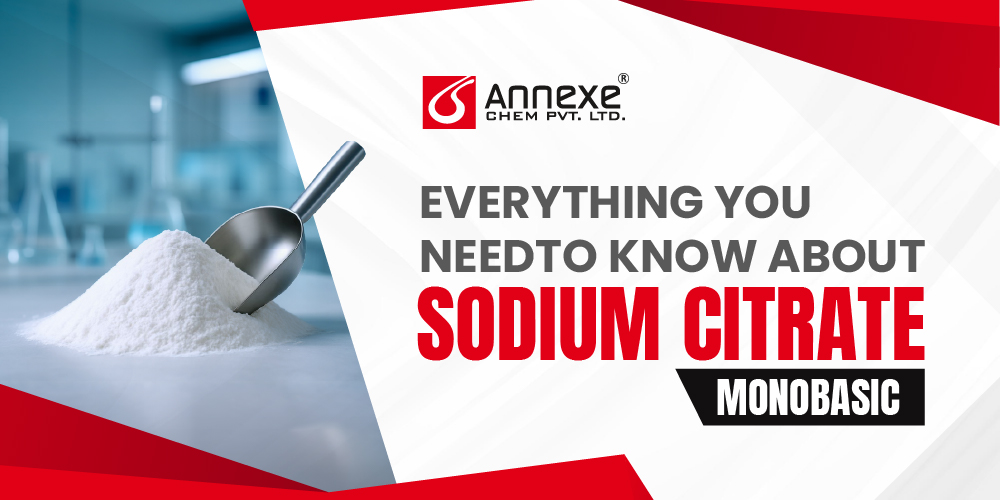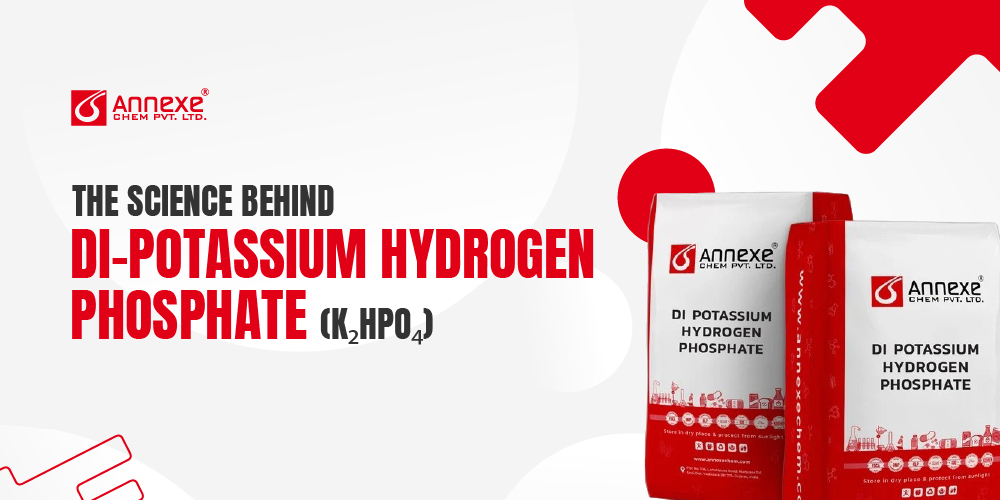The Comprehensive Guide to Sodium Dihydrogen Phosphate Dihydrate: Properties & Uses - Annexe Chem Pvt Ltd
The Comprehensive Guide to Sodium Dihydrogen Phosphate Dihydrate: Properties & Uses

- April 9, 2024
- By Akshita Patel
At its core, Sodium Dihydrogen Phosphate Dihydrate, with its chemical formula NaH2PO4.2H2O, embodies a symphony of atoms and bonds, offering a glimpse into the intricate dance of molecules within the realm of chemistry. While its name might sound daunting to the uninitiated, fear not, for we’re here to unravel its mysteries and shed light on its significance.
Beyond its chemical composition lies a world of properties waiting to be explored. From its physical characteristics to its chemical behavior, Sodium Dihydrogen Phosphate Dihydrate reveals a spectrum of traits that make it indispensable in numerous applications. But understanding its properties is just the beginning; delving deeper, we uncover its myriad uses spanning industries ranging from food and pharmaceuticals to water treatment.
However, no exploration would be complete without considering the implications for health, safety, and the environment. As we journey through the realm of Sodium Dihydrogen Phosphate Dihydrate, we’ll navigate the waters of potential hazards and environmental impacts, all while shining a light on innovations and research that push the boundaries of its applications.
Properties of Sodium Dihydrogen Phosphate Dihydrate
Sodium Dihydrogen Phosphate Dihydrate, with its unique chemical composition, exhibits a diverse array of properties that make it a versatile compound with wide-ranging applications across various industries. Understanding these properties is crucial for harnessing its full potential. Let’s delve into its physical and chemical characteristics:
Physical Properties:
- Appearance: Sodium Dihydrogen Phosphate Dihydrate typically presents as a white, crystalline powder or granules. Its appearance may vary depending on the manufacturing process and the presence of impurities.
- Solubility: In water, Sodium Dihydrogen Phosphate Dihydrate shows good solubility, dissolving readily to form a clear solution. The presence of water molecules within its structure enhances its solubility, facilitating its use in aqueous solutions and formulations.
- Melting Point and Boiling Point: The compound has a relatively high melting point, typically above 190°C. Its boiling point is significantly higher, reflecting its stability at elevated temperatures.
- Density: Sodium Dihydrogen Phosphate Dihydrate has a moderate density, which varies depending on factors such as crystal structure and moisture content.
Chemical Properties:
- Reactivity: As a salt of phosphoric acid, Sodium Dihydrogen Phosphate Dihydrate exhibits moderate reactivity. It can undergo chemical reactions with acids, bases, and certain metals, forming new compounds or participating in precipitation reactions.
- pH: In aqueous solutions, Sodium Dihydrogen Phosphate Dihydrate acts as a weak acid, contributing to the buffering capacity of the solution. Its pH depends on factors such as concentration and the presence of other substances in the solution. Typically, its pH falls within the acidic range, but it can vary depending on the specific conditions.
- Hygroscopicity: Due to the presence of water molecules within its structure, Sodium Dihydrogen Phosphate Dihydrate exhibits hygroscopic properties, meaning it can absorb moisture from the surrounding environment. This characteristic can influence its handling and storage requirements.
Stability: Under normal conditions, Sodium Dihydrogen Phosphate Dihydrate is stable and does not decompose rapidly. However, it may degrade under extreme conditions such as high temperatures or exposure to strong acids or bases.

Uses of Sodium Dihydrogen Phosphate Dihydrate
Sodium Dihydrogen Phosphate Dihydrate, renowned for its multifaceted properties, serves as a cornerstone in numerous industries, contributing to a spectrum of applications. Let’s delve deeper into its diverse uses:
1. Food Industry:
- Food Additive: Sodium Dihydrogen Phosphate Dihydrate is prized for its versatility as a food additive. Its ability to regulate pH levels makes it invaluable in food processing, where maintaining optimal acidity is crucial for flavor, texture, and preservation.
- Leavening Agent: In baking, it acts as a leavening agent by releasing carbon dioxide gas, causing the dough to rise and resulting in soft, fluffy baked goods like cakes, muffins, and bread.
- Emulsifier: As an emulsifying agent, it helps stabilize mixtures of water and oil, preventing them from separating. This property is particularly useful in salad dressings, mayonnaise, and sauces.
- Flavor Enhancer: Sodium Dihydrogen Phosphate Dihydrate can enhance the flavor of certain foods, contributing to a more balanced and palatable taste profile.
2. Pharmaceuticals:
- Laxative: Its laxative properties make it a key ingredient in over-the-counter medications designed to relieve constipation. By promoting bowel movements, it helps alleviate discomfort and regulate digestive health.
- Tablet Binder: In pharmaceutical tablet manufacturing, Sodium Dihydrogen Phosphate Dihydrate serves as a binder, ensuring that active ingredients are evenly distributed and securely held together, resulting in uniform and stable tablets.
3. Water Treatment:
- pH Adjustment: Municipal water treatment facilities utilize Sodium Dihydrogen Phosphate Dihydrate to adjust the pH of water supplies, ensuring they meet regulatory standards and are safe for consumption. By neutralizing acidic or alkaline water, it helps maintain a balanced pH level.
- Corrosion Inhibition: In industrial settings, it is employed as a corrosion inhibitor to protect metal pipes and equipment from degradation caused by exposure to corrosive substances present in water.
4. Detergent Manufacturing:
- Builder Agent: Sodium Dihydrogen Phosphate Dihydrate acts as a builder agent in detergent formulations, enhancing the effectiveness of cleaning agents by softening hard water and preventing the re-deposition of soil and mineral deposits onto surfaces.
5. Industrial Applications:
- Buffer Solution: Its buffering capacity renders it indispensable in various industrial processes requiring precise pH control, such as chemical synthesis, enzymatic reactions, and laboratory analyses.
- Catalyst Support: In certain catalytic reactions, Sodium Dihydrogen Phosphate Dihydrate may serve as a catalyst support or promoter, facilitating the conversion of reactants into desired products.
6. Agriculture:
- Fertilizer Component: Agriculture benefits from Sodium Dihydrogen Phosphate Dihydrate as a component of fertilizers, supplying essential nutrients like phosphorus to soil, which promotes healthy plant growth and improves crop yield.
7. Other Applications:
- Electroplating: It is utilized in electroplating baths to enhance the quality and durability of metal coatings, providing a smooth and corrosion-resistant finish.
- Flame Retardant: In certain industries, it functions as a flame retardant additive, imparting fire-resistant properties to materials such as plastics, textiles, and coatings, thereby improving safety in applications where fire hazards are a concern.
In essence, Sodium Dihydrogen Phosphate Dihydrate’s remarkable versatility and adaptability make it an indispensable component across a vast spectrum of industries, playing a pivotal role in enhancing product quality, performance, and safety. As technology advances and new applications emerge, its importance as a fundamental building block of modern manufacturing and innovation is likely to endure. In the intricate tapestry of chemistry, Sodium Dihydrogen Phosphate Dihydrate stands as a testament to the remarkable versatility and utility of chemical compounds. Throughout our exploration, we’ve witnessed its transformative impact across a multitude of industries, from food and pharmaceuticals to water treatment and beyond.
Annexe Chem Pvt Ltd, as a leading manufacturer and exporter based in Vadodara, India, stands at the forefront of delivering high-quality Sodium Dihydrogen Phosphate Dihydrate to meet the evolving needs of industries worldwide. With a commitment to excellence and innovation, we continue to drive advancements in chemical manufacturing, providing solutions that empower businesses and contribute to societal progress. As we look to the future, the potential applications of Sodium Dihydrogen Phosphate Dihydrate are boundless. As research and technology advance, new opportunities will undoubtedly emerge, further highlighting the importance of this remarkable compound in shaping our world.
Contact us today to explore how Sodium Dihydrogen Phosphate Dihydrate can elevate your products and processes.

Akshita Patel
As an advocate for sustainability, Akshita is committed to driving positive change within the chemical industry. She actively seeks out environmentally friendly solutions and promotes the adoption of sustainable practices. Akshita believes that a balance between economic growth and ecological responsibility is crucial for the industry's long-term success. She is dedicated to finding innovative ways to minimize environmental impact while maximizing efficiency and profitability.
Related Blogs

- April 22, 2025
- By Akshita Patel
Everything You Need to Know About.
When you think of essential ingredients in food, medicine, or even cosmetics, Sodium Citrate Mono Basic.

- March 25, 2025
- By Akshita Patel
The Science Behind Di-Potassium Hydrogen Phosphate.
Ever wondered what keeps your favorite processed foods fresh, enhances crop growth, and plays a vital.



